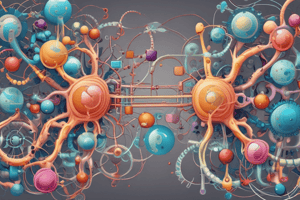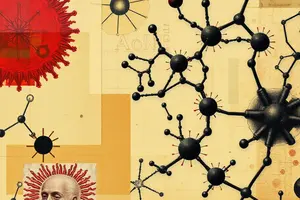Podcast
Questions and Answers
What type of catalysis involves the cleavage of bonds through the donation of a proton?
What type of catalysis involves the cleavage of bonds through the donation of a proton?
- Oxidation-reduction
- Proximity effect
- Nucleophilic substitution
- Acid-base catalysis (correct)
Which mechanism describes the stabilization of the transition state during enzymatic catalysis?
Which mechanism describes the stabilization of the transition state during enzymatic catalysis?
- Nucleophilic substitution
- Induced fit
- Transition-state stabilization (correct)
- Weak binding
What is the rate-limiting step in enzymatic reactions involving substrates and enzymes?
What is the rate-limiting step in enzymatic reactions involving substrates and enzymes?
- Binding of substrates to enzymes (correct)
- Release of product
- Cleavage of C-N bonds
- Formation of enzyme-substrate complex
What is the main role of the proximity effect in enzymatic catalysis?
What is the main role of the proximity effect in enzymatic catalysis?
Which type of enzyme is primarily responsible for the catalysis of superoxide dismutation?
Which type of enzyme is primarily responsible for the catalysis of superoxide dismutation?
What does the term 'induced fit' refer to in the context of enzyme-substrate interaction?
What does the term 'induced fit' refer to in the context of enzyme-substrate interaction?
What type of reaction is typically demonstrated by the action of triose phosphate isomerase?
What type of reaction is typically demonstrated by the action of triose phosphate isomerase?
What is the significance of pKa values for amino acids in proteins?
What is the significance of pKa values for amino acids in proteins?
Flashcards
Nucleophilic Substitution
Nucleophilic Substitution
A chemical reaction where a nucleophile (electron-rich atom or group) replaces a leaving group in a molecule.
Acid-Base Catalysis
Acid-Base Catalysis
Enzymatic catalysis where an acid or base donates or takes a proton, speeding up a reaction.
Enzyme Catalysis
Enzyme Catalysis
A process where enzymes (biological catalysts) accelerate chemical reactions by lowering activation energy.
Enzyme-Substrate Binding
Enzyme-Substrate Binding
Signup and view all the flashcards
Induced Fit
Induced Fit
Signup and view all the flashcards
Proximity Effect
Proximity Effect
Signup and view all the flashcards
Transition State Stabilization
Transition State Stabilization
Signup and view all the flashcards
Enzyme Activity and pH
Enzyme Activity and pH
Signup and view all the flashcards
Study Notes
Chapter 6: Mechanisms of Enzymes
- This chapter focuses on enzyme mechanisms.
- Homework problems to review: Chapter 6, problems 1, 3, 4, 5, and 10.
- Simple chemical mechanisms reviewed include nucleophilic substitutions, cleavage reactions, and oxidation-reduction reactions.
- Nucleophilic substitution reactions involve double bonds and detectable intermediates, or direct displacement and undetectable intermediates (transition states).
- Enzyme catalysis, including uncatalyzed reactions, effect of reactants bound by the enzyme, and reactants and transition states bound by the enzyme. Different reaction coordinate graphs are used to visualize these effects.
Energy Diagrams
- Energy diagrams illustrate the free energy changes during a single-step reaction or a reaction with an intermediate.
- Single-step reactions show a substrate, transition state, activation energy, change in free energy between substrate and product, and product.
- Reactions with intermediates have additional transition states, intermediates, and substrates along the reaction coordinate.
- The diagrams indicate the effect of enzymes on the activation energy of the reaction.
Catalytic Functions of Reactive Groups of Ionizable Amino Acids (Table 6.1)
- Table 6.1 lists amino acids, their reactive groups, net charges at pH 7, and their principal functions.
- Aspartate/Glutamate: Cation binding/proton transfer
- Histidine: Proton transfer
- Cysteine: Covalent binding of acyl groups
- Tyrosine: Hydrogen bonding to ligands
- Lysine: Anion binding
- Arginine: Anion binding
- Serine: Covalent binding of acyl groups
pKa Values of Amino Acids (Table 6.2)
- Table 6.2 presents typical pKa values of ionizable groups of amino acids in proteins, distinguishing between free amino acids and those in proteins.
Frequency Distribution of Catalytic Residues in Enzymes (Table 6.3)
- Table 6.3 shows the percentage of catalytic residues and all residues in various amino acids within enzymes.
- His, Asp, Arg, Glu, Lys, Cys, Tyr, Asn, Ser, Gly.
Acid-Base Catalysis
- Acid-Base catalysis involves the donation or acceptance of protons by amino acid side chains in the active site.
- This process generally involves cleavage of C-N with water and :B.
- Reactions involving acid-base catalysis, including donation of H by HB+, affect reaction speed or rate.
pH Affects Enzymatic Rates (Example: Papain)
- pH influences enzyme activity, particularly evident in papain.
- The optimal pH for enzymes varies based on the particular active site amino acid pKa values to stabilize the active site.
- The relationship between enzyme activity and pH forms an overall pH rate profile.
Activation of Pancreatic Zymogens (Figure 6.21)
- Pancreatic zymogens, including trypsinogen, chymotrypsinogen, and proelastase, are inactive forms of enzymes.
- Enteropeptidase activates trypsinogen, which further activates other zymogens (e.g., chymotrypsinogen).
- This cascade leads to the activation of chymotrypsin and elastase, important digestive enzymes.
Homologous Enzymes: Chymotrypsin, Trypsin, and Elastase (Figure 6.23)
- These enzymes share a similar fold, indicating a common evolutionary origin.
Binding Sites of Chymotrypsin, Trypsin, and Elastase (Figure 6.24)
- Displays the binding sites of the three enzymes.
- The binding sites are uniquely shaped to accommodate specific substrates.
Catalytic Triad of Chymotrypsin (Figure 6.26)
- The catalytic triad includes Asp-102, His-57, and Ser-195.
- These amino acid residues collaborate in the catalytic mechanism of chymotrypsin.
Rate-Limiting Step: Binding of E and S
- The rate of an enzyme catalyzed reaction can be affected by how quickly the enzyme and substrate bind to each other, as shown by Table 6.4.
Triose Phosphate Isomerase (Figures 6-7, 6-8, 6-9)
- This enzyme catalyzes the interconversion of dihydroxyacetone phosphate (DHAP) and D-glyceraldehyde 3-phosphate (G3P), a key step in glycolysis.
Superoxide Dismutase (Figures 6.10,6-23)
- This enzyme catalyzes the dismutation of superoxide radicals to hydrogen peroxide, playing a role in reducing oxidative stress in cells.
Binding Modes of Enzymatic Catalysis
- Proximity effect: Substrates are brought closer together in the enzyme's active site
- Weak binding of substrate to enzyme: Transient interactions between enzyme and substrate are essential for catalysis.
- Induced Fit: The enzyme changes shape upon substrate binding to enhance the fit between the enzyme and substrate.
- Transition state stabilization: Enzymes stabilize the transition state, reducing the activation energy required for the reaction.
- Enzyme-substrate/product and intermediate diagrams show the mechanism behind each mode of enzymatic catalysis.
Substrate of Lysozyme: Bacterial Cell Wall Polysaccharide (Figure 6.17)
- Lysozyme cleaves the polysaccharide, targeting a β(1→4) linkage between N-acetylmuramic acid (MurNAc) and N-acetylglucosamine (GlcNAc).
- The substrate's structure is crucial to enzyme action.
Conformations of N-Acetylmuramic Acid (Figures 6.19a, 6.19b)
- Display different conformations of MurNAc, showing structural diversity and importance to enzyme interaction.
Activation of Pancreatic Zymogens (Figure 6.21)
- Shows the cascade of enzyme activation involving trypsinogen, chymotrypsinogen, and proelastase, which are converted by enteropeptidase, trypsin, and other enzymes.
Catalytic Site of Chymotrypsin (Figure 6.25)
-
The active site's three residues (Asp-102, His-57, Ser-195) are shown.
-
The different forms and the various modes of enzyme actions are visually conveyed using graphs and diagrams related to enzymes and their processes.
Studying That Suits You
Use AI to generate personalized quizzes and flashcards to suit your learning preferences.



